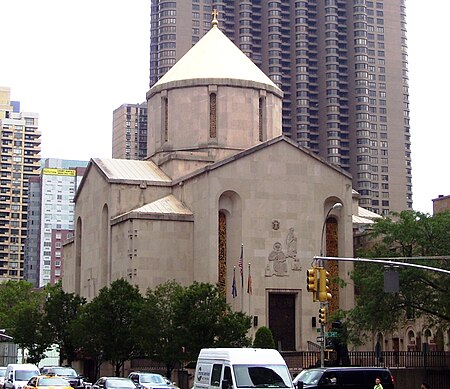St. Vartan Armenian Cathedral
20th-century Oriental Orthodox church buildings34th Street (Manhattan)Armenian-American culture in New York CityArmenian Apostolic cathedrals in the United StatesCathedrals in New York City ... and 4 more
Churches completed in 1963Churches in ManhattanKips Bay, ManhattanSecond Avenue (Manhattan)

St. Vartan Armenian Cathedral (Armenian: Սուրբ Վարդան Մայր Տաճար) in New York City is the first cathedral of the Armenian Apostolic Church to be constructed in North America. It is located in New York City on the corner of Second Avenue and Thirty-fourth street and was built to resemble the Saint Hripsime Church in Etchmiadzin (Vagharshapat). St. Vartan's was consecrated on April 28, 1968, by Vazgen I, Catholicos of Armenia and of All Armenians.
Excerpt from the Wikipedia article St. Vartan Armenian Cathedral (License: CC BY-SA 3.0, Authors, Images).St. Vartan Armenian Cathedral
2nd Avenue, New York Manhattan
Geographical coordinates (GPS) Address Website External links Nearby Places Show on map
Geographical coordinates (GPS)
| Latitude | Longitude |
|---|---|
| N 40.745131 ° | E -73.975252 ° |
Address
St. Vartan Cathedral
2nd Avenue 630
10035 New York, Manhattan
New York, United States
Open on Google Maps








